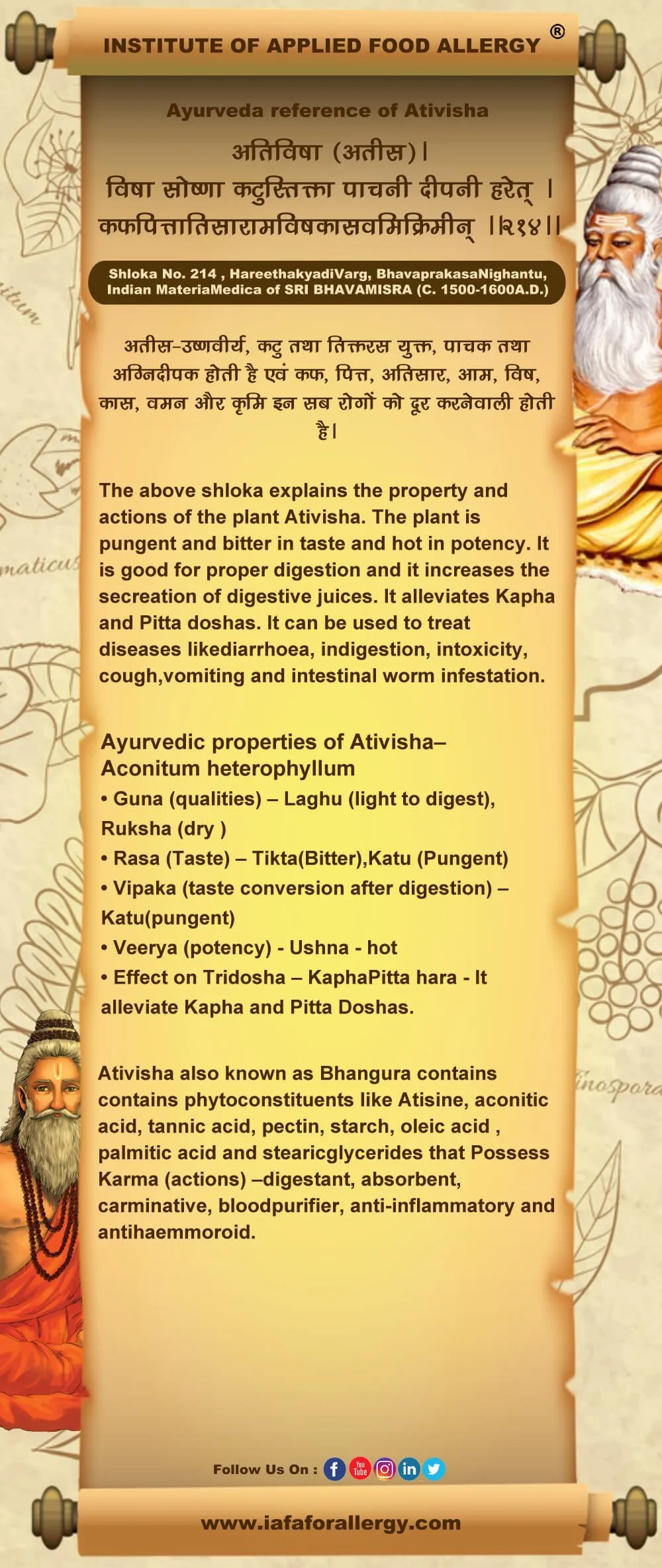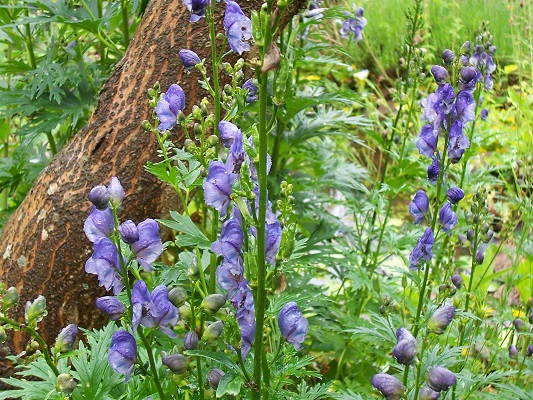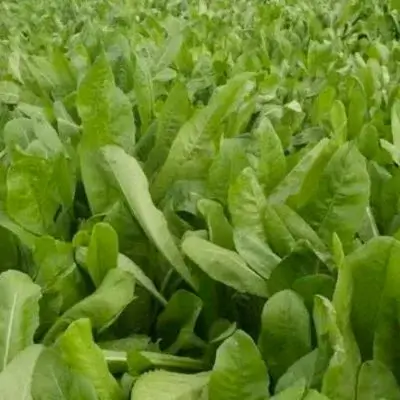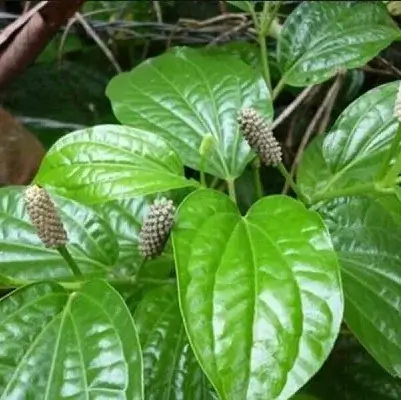On This Page
Ativisha (Aconitum heterophyllum) – Uses and Benefits
Introduction
Ativisha is a worldwide known plant having many medicinal values. Though it is not having poisonous effect, it is mentioned in Upavisha category in Ayurveda. It possess many medicinal properties. It is a popular drug used in children’s diseases, hence got the name Shishu Bhaishajya. As it breaks very easily, it is also known as Bhangura.
Dr. Gupta’s IAFA has been working on Ativisha plant for discovering more medicinal properties. Our experts found out that the plant can act as an antiallergic, anti-inflammatory, digestant, expectorant and diuretic agent. It is very effective in cough and fever in children. Ativisha can also be used for diseases like dysentery, vomiting, stomach disorders, helminthiasis, malarial fever, haemorrhoids, haemorrhages, internal inflammatory conditions etc. It also possesses hepatoprotective activity. The plant shows potent immunostimulant properties also. The chemical studies of the plant have revealed that various parts of the plant contain alkaloids, carbohydrates, proteins and amino acids, saponins, glycosides, quinones, flavonoids, terpenoids, etc.
Action of Ativisha – Aconitum heterophyllumin Allergies
IAFA has been conducting various studies on Ativisha to found out the antiallergic and anti-inflammatory properties of the plant. The plant contains phytoconstituents like Atisine, a non-Crystalline
substance which is bitter and non-toxic. Besides this, it also contains
aconitic acid, tannic acid, pectin, starch, oleic acid, palmitic acid, stearicglycerides.
Vernacular Names
| Sanskrit Name | Ativisha, Aruna, Bhangura |
| Hindi Name | Atis |
| English Name | Indian atees |
| Malayalam Name | Atividayam |
| Tamil Name | Atibaje |
| Telugu Name | Ativasa |
Botanical Name
Aconitum heterophyllum
Family
Ranunculaceae
Morphology of Ativisha – Aconitum heterophyllum
- Plant grows upto 60 cm
- Stem – erect and branches are compressed
- Leaves – ovate-cordate, lower leaves are broader in size than the upper ones
- Flowers – blue or violet in colour
- Fruits – smaller in size
- Seeds – blackish in colour
- Roots – biennual, horn shaped and fragile
Ayurveda Reference of Ativisha – Aconitum heterophyllum

Geographical Distribution of Ativisha–Aconitum heterophyllum
Ativisha is distributed in India, Pakistan, Nepal. In India it grows in high altitude like Kashmir and Madradesa.
Phytoconstituents of Ativisha – Aconitum heterophyllum
The plant Ativisha contains phytoconstituents like Atisine, a non-Crystalline
substance which is bitter and non-toxic. Besides this, it also contains
aconitic acid, tannic acid, pectin, starch, oleic acid, palmitic acid, stearicglycerides.
Parts Used of Ativisha – Aconitum heterophyllum
- Root tuber
Dosage of Ativisha – Aconitum heterophyllum
- Powder (churna) – 0.6 -2 gm
Medicinal Properties of Ativisha – Aconitum heterophyllum
- Deepani – increases the secretion of digestive juices
- Pachana – helps to the digestion of indigested food
- Grahi – absorbent
- Arsoghna – useful in piles
- Krimighna – removes worm infestation
- Visaghna – anti toxic
- Rakthasodaka – purifies blood
- Sothahara – relieves swelling
- Jvaraghna – relieves fever

Have A Health Issue?
Consult Online
- Dr. Sahil Gupta (B.A.M.S., M.H.A.)
Ayurvedic Allergy Specialist
CEO & Founder of IAFA®
Home Remedies of Ativisha – Aconitum heterophyllum
Ayurveda is purely based on naturally available herbs for treatment purposes. Ativisha is a easily available plant and can be used to treat diseases like:-
- Cough in children (Kasa) – 0.5 g of Ativisha powder is given along with honey for 3 days
- Dysentery (Atisara) – 1 g of powder along with Vacha powder and honey two times for 2 days.
- Grahani (IBS) – Decoction prepared from Ativisha, Vacha and Mustha is given orally for 7 days
- Ulcers (Vruna) – Syonaka, Kantakari and Ativisha are made into paste and applied over the wounds.
- Intestinal worm infestation (Krimi) – Powder of ativisha (1gm) and vidangam (2gm) along with honey is taken internally for 5 days.
- Rat bite (Mushikadamsa) – Root of Ativisha is made into paste and taken internally along with honey.
- Fever (Jvara) – Decoction of Ativisha along with Sunti is taken internally for 3 days.
- Indigestion (Ama) – 2 gm of Ativisha powder along with honey is taken internally for 3 days.
Dr. Gupta’s IAFA is one of the organizations to provide safe, pure and nontoxic Ayurvedic medicines. Our treatment protocols are strictly based on Ayurvedic principles. We mainly focus on alleviating allergic disorders by using naturally available herbs which have less to no side effects. We make sure the safety of our customers by subjecting our products to various tests.
Reach IAFA for safe herbal remedies for all your ailments!!!
Was this Page Helpful?
Read More Articles

Kasini (Cichorium intybus)
Know about the uses, benefits, and medicinal properties of Chicory, Kasini (Cichorium…









